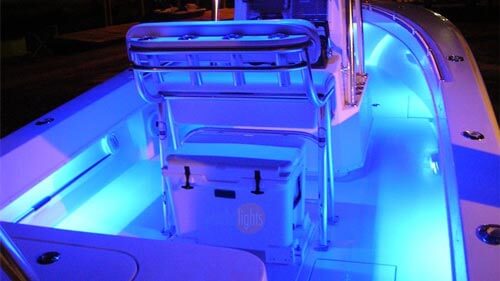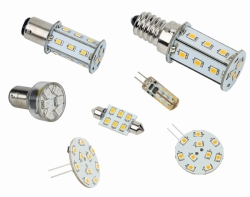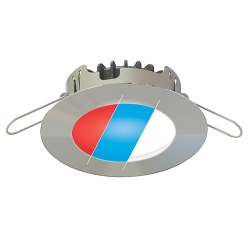Interior Update: Shedding Light on LED
By Jordan Balbresky

As boaters, we want our time on the water to be easy and enjoyable, and our boat should feel homey and inviting.
Aside from the most recent builds, most boats have been built with either incandescent or halogen bulb lighting. Inevitably, these bulbs burn out and the fixtures start to age and look dated. Sometimes, after a few years of use, you might just be ready for a totally new look and feel. After all, if you use your boat at night, lighting is absolutely necessary for safety, navigation, and the livability of your boat.
When looking online or in one of the many printed catalogs, you may have noticed the number of products in the lighting section has grown quite a bit and the options are dizzying. However, replacements for older bulbs and fixtures are getting harder to find. LED lighting has been installed by most boat builders as standard since approximately 2008 and the technology has edged out incandescent and halogen bulbs in terms of popularity.
Whether you are considering a winter refit or just a quick upgrade, I thought I’d shed a little light on the pros and cons of switching to interior LED lighting.
For this, I went right to the experts. Colby Chevalier, Director of Product Management for IMTRA, one of the leading distributors and manufacturers of LED lighting products in the country, answered my questions about the advantages and disadvantages of converting to LED lighting.

Pros and Cons of LED Lighting
The two key advantages that originally brought boat owners to LED lighting were reduced power consumption and virtually no radiated heat. An LED light may draw only 3-5W apiece vs. the 20-25W for an equivalent light with a halogen bulb. Switching to LED means your battery charge is extended, with the added benefit of cooler interior spaces.
If you’re a cruiser that spends more time at anchor or on a mooring than you do plugged into a dock, this energy saving means less time running your engine or generator to keep your boat lit up at night. This is particularly beneficial for sailors who don’t spend much time running their engine while underway.
Halogen and incandescent lighting use a heated filament to emit light. That filament, as it heats up, emits light in all directions equally, meaning that a downlight with a filament bulb is throwing just as much light upwards into the body of the fixture as downwards towards the space it is meant to illuminate. By comparison, an LED fixture uses diodes which emit light in only one direction. This means an LED fixture would emit light only in the specific direction it is intended to with very little of the light output wasted and at a much lower temperature.

Also, because an LED fixture is a collection of light-emitting-diodes secured to an LED-driver-board, they can easily be made to be multi-colored by populating that board with diodes that emit different colors. One LED fixture or bulb is capable of emitting multiple light colors both within the white color spectrum – warm white and cool white, or neutral/natural white – or, by incorporating red, green, and blue diodes, they can offer an almost infinite range of color combinations through a single fixture.
Conversely, halogen and incandescent bulbs can emit only the color the filament produces when electricity runs through it. This means a halogen or incandescent fixture must use a number of bulbs or colored lenses to produce multiple colors.
Yet another benefit of LED lighting, particularly in marine applications where boats are operating in possibly rough seas or have the constant vibration of motors and generators, is durability. The industry standard for the lifespan of an LED fixture is roughly 50,000 hours. As anyone who has used filament-style bulbs in their home or boat knows, halogen and incandescent bulbs do not last nearly that long.
One reason for this is the fragility of a filament. If a halogen or incandescent bulb shakes or vibrates, there’s a chance the filament will break causing the bulb to fail. LED fixtures are solid-state, so vibrations do not harm the light.
For all the benefits, LED lighting is not without disadvantages, the main one to consider is price. While the quality of the bulb or fixture plays a large role, the cost of an LED product is likely to be more expensive than an equivalent halogen or incandescent product. At the end of the day, an LED fixture is a piece of electronics, with many sub-components that add to the cost.
A halogen or incandescent fixture only needs to pass electricity through a filament, so the simplicity of it makes it easier to manufacture, resulting in a lower cost.
Options for Upgrading
When refitting an existing boat, you have a couple of options. They do make LED “bulbs” that fit into many existing incandescent fixtures. While you get most of the benefits of LED technology, these bulbs usually produce a “dotted” effect without a diffuser. You can replace the existing fixture with a completely new fixture, though this limits you to the current footprint in terms of cutout, recessed depth, and overall diameter of the lights that are in place.
The good news is most LED fixtures are now designed to drop in to many of the existing size lights. However, the difference in dimming processes becomes a particular disadvantage for re-fitting your boat from halogen to LED, because not only the fixtures or bulbs have to be replaced, but also the dimmer and often the switch that controls the dimming as well.

For an easy DIY project that adds LED lighting and beautiful design elements to any boat, consider the IMTRA St. Maarten Reading Light. Featuring beautiful hand-blown glass shades in a variety of colors, the elegant line includes a USB port for convenient charging of electronic devices. Handcrafted by master glassblowers at the Pairpoint Glass Company, using techniques and original tools that date back to the early 1800’s, the St. Maarten range features chromed brass with round and rectangular base fixtures for a sophisticated look.
Whether you are thinking about adding a reading light to a bunk or revamping the entire lighting scheme of the interior of your vessel, LED technology has a lot to offer. The best way to learn what options are available is to talk to your boat yard or local lighting installer. For more information about LED lights, visit www.imtralearning.com.